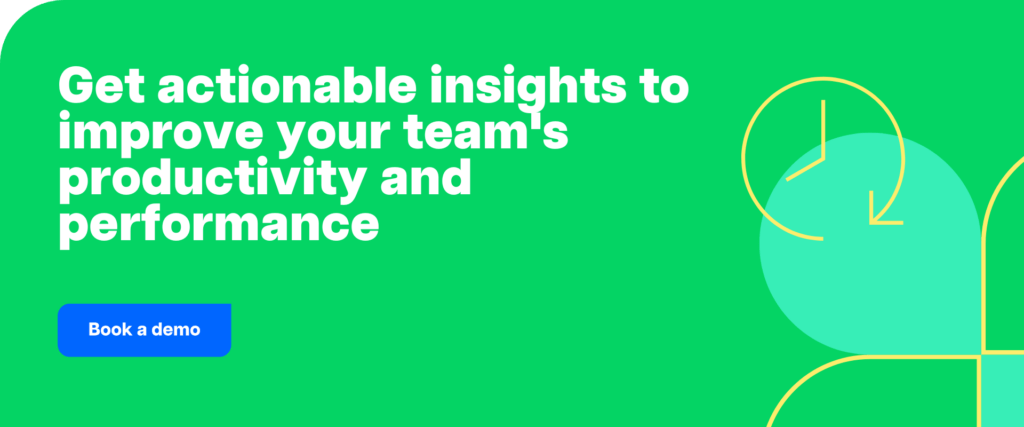How do you know if your employees are truly performing—or just looking busy? A 2023 Slack report found that 30% of employees’ work is ‘performative’—meaning it doesn’t drive real business outcomes.
The word ‘performance’ has a few meanings. It can refer to artistic displays put on by actors and musicians, or—more generally—how a person carries out an action. In the workplace, employee performance is defined by how well a staff member meets the responsibilities of their role and adheres to a company’s values and standards.
A key challenge for managers and leaders is feeling confident they know whether employees are really performing well, or just putting on a convincing act.
That’s why we’re sharing the fundamentals of why employee performance matters, what actually contributes to excellent performance, and how you can understand and address employee performance issues.

Table of Contents
- Why is it important to measure employee performance?
- What are the most common performance management mistakes?
- What are the factors that affect employee performance?
How do you improve employee performance in a remote team? - Key employee performance metrics to track
- The role of leadership in enhancing performance
- What happens when employees perform poorly?
- How can employee performance issues be identified and addressed?
Why is it important to measure employee performance?
Over the past decade, employee performance management has shifted from a once-yearly, ratings-based focus on whether someone deserves a raise—to a continuous improvement imperative, based on regular feedback, coaching and career development.
There are three important reasons to gather data and input from your team as part of an improvement-focused monitoring approach:
1. Employee performance is not an end-of-year afterthought
If you want to ensure high-level business goals are being met and company values are being upheld, you need to understand execution (and barriers or issues with execution) at the employee and team-level—all year round.
A study by Mercer found 70% of HR leaders think there’s vast room for improvement in linking performance management processes to better day-to-day talent management.
2. Employee performance is not one dimensional
Employee performance is tied to a holistic view of individual workers’ outputs, attitudes and behaviours. Efficiency, quality and effectiveness must be counterbalanced by an ability to communicate well, maintain wellbeing, interact with others respectfully, and behave ethically.
For instance:
- At face value an employee can seem highly efficient—but on closer inspection you might find they’re doing work that isn’t a priority and not meeting quality standards.
- A sales rep might be exceeding her targets, but maybe she’s working excessive hours, not engaging with her team, and is close to burnout or quitting.
3. Employee performance requires rich data to understand
Measuring and evaluating performance requires a multitude of indicators and insights based on both qualitative and quantitative metrics. As a people manager or executive, you can’t rely solely on your impression of a person’s productivity or likability.
This is especially true in modern hybrid and remote workplaces, where visibility of team members can’t easily guide your perception of their performance. But even when everybody’s attending the office in person, digital workflows require digital workforce monitoring tools to get an accurate idea of employee performance.
What are the most common performance management mistakes?
Effective performance management is crucial for business success, but many organizations make mistakes that negatively impact employee engagement and productivity. Here are some of the most common errors and how to avoid them:
1. Focusing only on annual reviews instead of ongoing feedback
- Traditional performance reviews that happen once a year often fail to provide timely feedback.
- Employees need real-time coaching and regular check-ins to stay on track.
Solution: Implement continuous feedback loops through monthly or quarterly reviews, peer feedback, and real-time performance tracking.
2. Measuring the wrong metrics, such as activity over results
- Some managers track how busy employees look instead of measuring real outcomes.
- Hours logged, emails sent, or meetings attended don’t always reflect true productivity.
Solution: Focus on key performance indicators (KPIs) that align with business goals, such as task completion rates, revenue impact, or customer satisfaction.
3. Neglecting employee well-being,leading to burnout
- Overloading employees with work without considering their mental and physical well-being leads to decreased performance and high turnover.
Solution: Encourage work-life balance by setting reasonable workloads, offering wellness programs, and using time-tracking insights to prevent overwork.
4. Failing to provide growth opportunities, causing disengagement
- Employees become demotivated when they see no clear career path or skill development opportunities.
Solution: Offer training, mentorship, and upskilling programs to help employees advance in their roles. Use performance tracking to identify skill gaps and provide targeted learning opportunities.
5. Ignoring team dynamics and collaboration, which affects performance
- Performance management often focuses too much on individual contributions, ignoring team collaborationc and workplace relationships.
- Poor communication and lack of teamwork can lower efficiency and job satisfaction.
Solution: Encourage cross-team collaboration, foster a feedback-friendly culture, and recognize team-based achievements, not just individual performance.
What are the factors that affect employee performance?
Employees will have various intrinsic and extrinsic motivations for performing at a high level. Some people are innately conscientious while others are more driven by competition or striving for a bonus.
Individual performance is also a product of the work environment and culture. You have the power to foster improved employee performance through company-wide policies and people management approaches.
Some common ways companies motivate employee efforts include:
- Remuneration and benefits
- Employee engagement strategies
- Reward and Recognition programs
- Succession planning and internal mobility programs
You should also carefully design and support these work aspects to positively influence employee performance:
1. Goal-setting
Goals keep employees on track, which allows them to perform well. Ultimately, employees need clear direction from the top about the vision, mission and the steps required to achieve goals.
When setting individual goals, where things can go awry include:
- Making goals too easy, vague and low-level. While goals should be achievable, everyone should factor in some stretch goals that give them a challenge.
- Not involving employees. Gallup research finds that when managers involve direct reports in goal setting, employees are 3.6X more likely to be engaged.
- Making goals too difficult and inflexible. This can pressure people to lose sight of the big picture, become overwhelmed or act dishonestly to avoid failure.
2. Physical environment
The literal comfort of employees as they hit the tools is important for performance—whether they’re in-office or working from home. Consider ergonomically-sound desk set-ups, which might include customisable chairs, sit-stand desks and specialised keyboards, to ensure people have the correct posture and can avoid physical strain while working.
Also pay attention to facets of your office like lighting, greenery, artwork, noise, temperature, access to private spaces and break rooms if you’re serious about driving employee performance.
3. Streamlined tools and processes
Too many systems and steps to get work done is a common complaint among high performers. They want simplified workflows that allow them to have greater autonomy over when and how they complete tasks—provided they achieve the desired outcome. It helps to provide:
Consolidated information systems for 24/7 access to information, and productivity tools that support asynchronous work, so people experience fewer interruptions during their day.
Integrated apps that allow employees to use a wider range of required tools yet minimise the need to switch between multiple different platforms—which previous studies have shown can cause more than 50% of workday interruptions.
4. Managerial support and feedback
Clear and constructive feedback, praise and support from leaders, delivered regularly, serves the dual purpose of lifting performance by:
- Encouraging underperforming employees to identify, take ownership and tackle problems, so they can improve and develop into high-performing employees.
- Reinforcing what high performers are doing right and how it contributes to the business, so they stay focused and feel engaged and valued.
It’s critical for people managers to overcome the discomfort or fear that feedback won’t be well-received. Research shows it’s helpful to simply take the perspective of the potential feedback-receiver—would they appreciate knowing you’re paying attention and want them to succeed?
5. Skills, training and learning culture
Offering training and cultivating a culture of learning improves performance because it instils new knowledge, skills and confidence in employees. Improved competence and knowledge-sharing drives employee performance.
For instance, an employee who receives targeted training in software they’re required to use daily—which could be through an online course or even peer-to-peer learning—is more likely to use the software’s features efficiently and deliver more polished outputs.
Keep in mind, there’s no one-size-fits-all solution when it comes to professional development: so having insights into individual employee performance is key to creating personalized training plans.
How do you improve employee performance in a remote team?
Improving employee performance in a remote team requires a strategic approach that fosters accountability, engagement, and efficiency. Here’s how you can create a high-performance remote work environment:
1. Set clear goals and expectations
Remote employees need clarity on their roles, responsibilities, and deliverables. Without physical supervision, ambiguity leads to misalignment and lower performance.
- Define SMART goals (Specific, Measurable, Achievable, Relevant, Time-bound) for each team member.
- Use project management tools like Asana, Trello, or Monday.com to ensure everyone understands priorities and deadlines.
- Clearly communicate KPIs (Key Performance Indicators) to measure performance fairly.
2. Use time tracking and productivity tools like Time Doctor
Without the visibility of an office setting, time tracking and productivity analytics tools help managers understand how remote employees spend their workday.
- Time Doctor provides real-time insights into work patterns, time spent on tasks, and productivity trends.
- Automated timesheets and attendance tracking ensure accurate payroll and reduce inefficiencies.
- Features like idle time detection and website tracking help employees stay focused and avoid distractions.
3. Encourage regular check-ins and open communication
One of the biggest challenges of remote work is feeling disconnected from managers and teammates. Frequent check-ins and open communication help bridge this gap.
- Schedule daily stand-ups or weekly 1-on-1s to align on progress and challenges.
- Use tools like Slack, Zoom, or Microsoft Teams for easy and informal communication.
- Encourage an open-door policy where employees feel comfortable sharing concerns.
4. Support flexible work schedules to balance productivity and well-being
Remote work should promote autonomy, not micromanagement. Employees are more productive when they have control over their schedules.
- Allow flexible working hours based on productivity peaks.
- Focus on outcome-based performance rather than hours worked.
- Promote work-life balance by encouraging breaks, setting meeting-free hours, and discouraging overwork.
5. Offer training and development to keep skills up to date
Without in-person interactions, learning and skill development can become secondary in remote settings. However, companies that invest in employee growth see higher engagement and retention.
- Provide online training courses through platforms like Udemy, LinkedIn Learning, or Coursera.
- Encourage peer-to-peer learning by pairing employees for knowledge-sharing sessions.
- Offer career development opportunities by mapping out growth paths within the company.
Why these strategies matter
By implementing these best practices, remote teams can stay engaged, productive, and aligned with company goals. Using the right mix of technology, communication, and flexibility, organizations can improve employee performance while maintaining a positive remote work culture.
Key employee performance metrics to track
To accurately assess and improve employee performance, businesses should track a mix of quantitative and qualitative performance metrics.
1. Productivity metrics
- Tasks completed on time vs. missed deadlines.
- Project turnaround time and efficiency levels.
- Sales revenue generated (for sales teams).
2. Quality of work metrics
- Error rates in deliverables (e.g., defect rates, customer complaints).
- Customer satisfaction scores (CSAT, NPS).
- Internal review ratings from managers or peers.
3. Engagement & retention metrics
- Employee Net Promoter Score (eNPS) – measures how likely employees are to recommend the company.
- Turnover rates – high turnover may signal poor engagement or work conditions.
- Absenteeism rates – frequent unplanned absences may indicate burnout or low morale.
4. Collaboration & teamwork metrics
- Peer feedback and 360-degree reviews – qualitative insights into communication, leadership, and collaboration.
- Participation in team meetings and projects.
- Cross-departmental contributions.
5. Digital productivity metrics (For hybrid & remote teams)
- Software & tool usage efficiency – tracking which apps contribute to real work vs. distractions.
- Focus time vs. distractions – measuring deep work periods vs. time spent on emails or meetings.
A balanced mix of these metrics provides a more accurate view of performance—ensuring that companies focus on results, not just effort.

The role of leadership in enhancing performance
Company leaders play a critical role in setting off a chain reaction that unleashes strong individual performance across the organization. In particular, leadership is essential for continuous feedback, as discussed above.
Feedback from a leader can have more impact, because it makes employees feel seen and appreciated. When leaders also ask for feedback it:
- Enhances their ability to meet their team’s needs and offer better guidance.
- Opens the lines of communication, which improves psychological safety and trust.
Organizational culture is also largely shaped by leaders. Leadership behaviours and values often spread like a contagion throughout an organization—which can be positive and negative.
- On the positive side, inspiring leaders who model ethical and collaborative high performance can energise their teams to push themselves to achieve the company vision. This is evidenced by high levels of discretionary effort, optimism and teamwork.
- On the negative side, toxic leaders who model arrogant, unaccountable and dishonest behaviours can breed those same behaviours in subordinates. This can result in increased mistrust, low commitment, more cutting corners and higher turnover.
What happens when employees perform poorly?
In a worst-case scenario, employees who don’t meet expectations in their role can get your company in serious hot water by ignoring legal and compliance obligations, or undertaking criminal and unethical activities.
Average performance doesn’t seem like a huge risk, but it gradually erodes your company’s competitive edge. When employee performance is subpar, it has ripple effects across your business:
- Individuals can lose confidence, become disengaged and quit.
- Teamwork can suffer due to poor collaboration, re-work and resentment.
- Employees add less value, adding to the costs of talent management.
- Company culture can wane, making you less attractive to new hires.
- Clients can become unsatisfied, make complaints or leave.
- Company growth, reputation and revenue can all decline.
You need to reduce poor performance—but focus even more on raising everyone’s level by creating a high-performance workplace.
A 2023 Gartner survey found only 29% of HR leaders were confident that their organizations’ current processes would effectively help employees achieve and sustain their best possible performance.
Gartner argues that to optimize employee performance, employers need to provide ‘performance clues’ as guidance, such as:
- Providing strategic context about business decisions, while also enabling autonomy in relation to daily tasks.
- Incorporating wellness into work approaches to help employees set a sustainable pace, as well as encouraging them to care for themselves.
- Showing employees when success is achieved in real-time and recognising high performance at salient moments, to reinforce and drive desirable progress.
How can employee performance issues be identified and addressed?
It’s difficult to fully measure and influence employee performance, and having metrics isn’t enough on its own.
But hard data about employee activity, what they’re spending time on, and how they’re getting work done is a great start. Especially when employees are active participants in managing their own time and projects via monitoring tools—such as Time Doctor’s employee-friendly interface.

Time Doctor makes performance more transparent company-wide. That encourages individuals to improve their self-management, and gives people managers and company leaders tangible facts to base conversations about performance on or instigate organizational change.
For example, with Time Doctor’s in-depth workforce analytics and reporting features you can:
- See when people work, their daily patterns of work, and get tipped off when people are working unusual or excessive hours and could be at risk of burnout.
- Get objective insights in real-time that help you offer immediately useful feedback, recognise high performers, and hold both individuals and those who manage them to account.
- Compare activity and productivity levels across various teams within your organization to spot performance constraints related to resourcing or management.
- Identify which software and online apps actually contribute to high performance or are potentially time-wasters or not being utilised effectively.
What’s more, Time Doctor has in-built features to help prevent possible ‘gaming’ of our app, such as mouse jigglers and idle windows. There’s no place for performative work when you create a stimulating work environment and have the right systems to measure and improve employee performance.
Book a free demo with Time Doctor today and discover our powerful workforce analytics tools.

Carlo Borja is the Content Marketing Manager of Time Doctor, a workforce analytics software for distributed teams. He is a remote work advocate, a father and an avid coffee drinker.


